Microfluidics Market Size
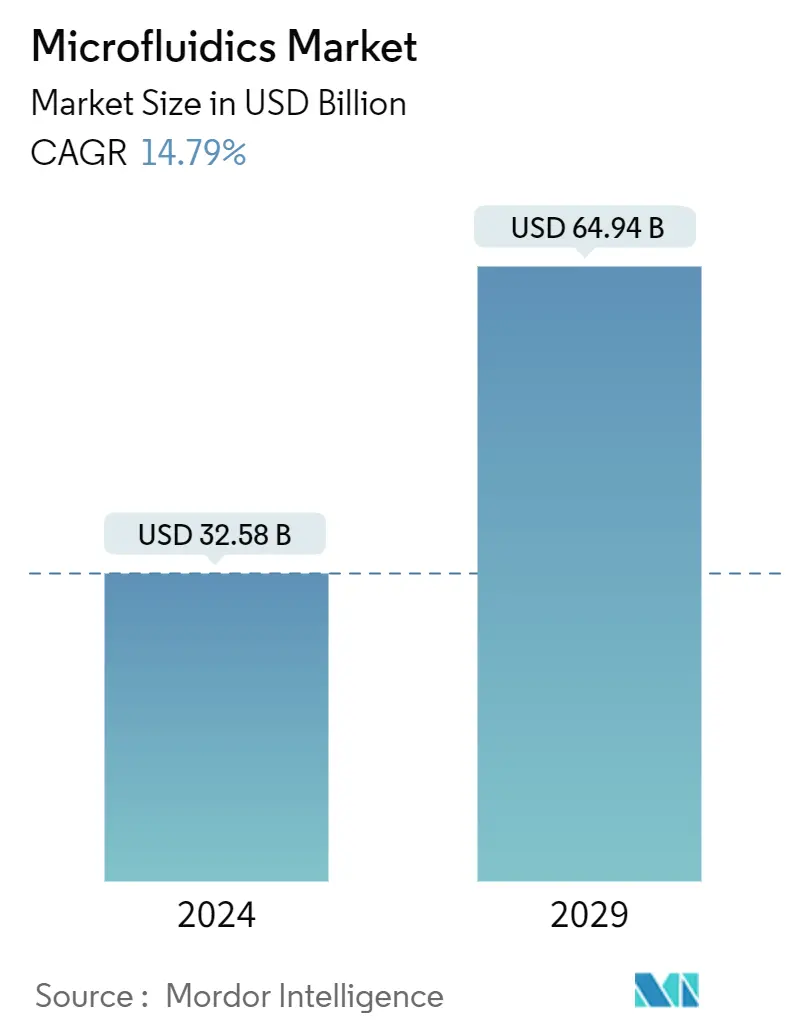
| Study Period | 2019 - 2029 |
| Market Size (2024) | USD 32.58 Billion |
| Market Size (2029) | USD 64.94 Billion |
| CAGR (2024 - 2029) | 14.79 % |
| Fastest Growing Market | Asia Pacific |
| Largest Market | North America |
Major Players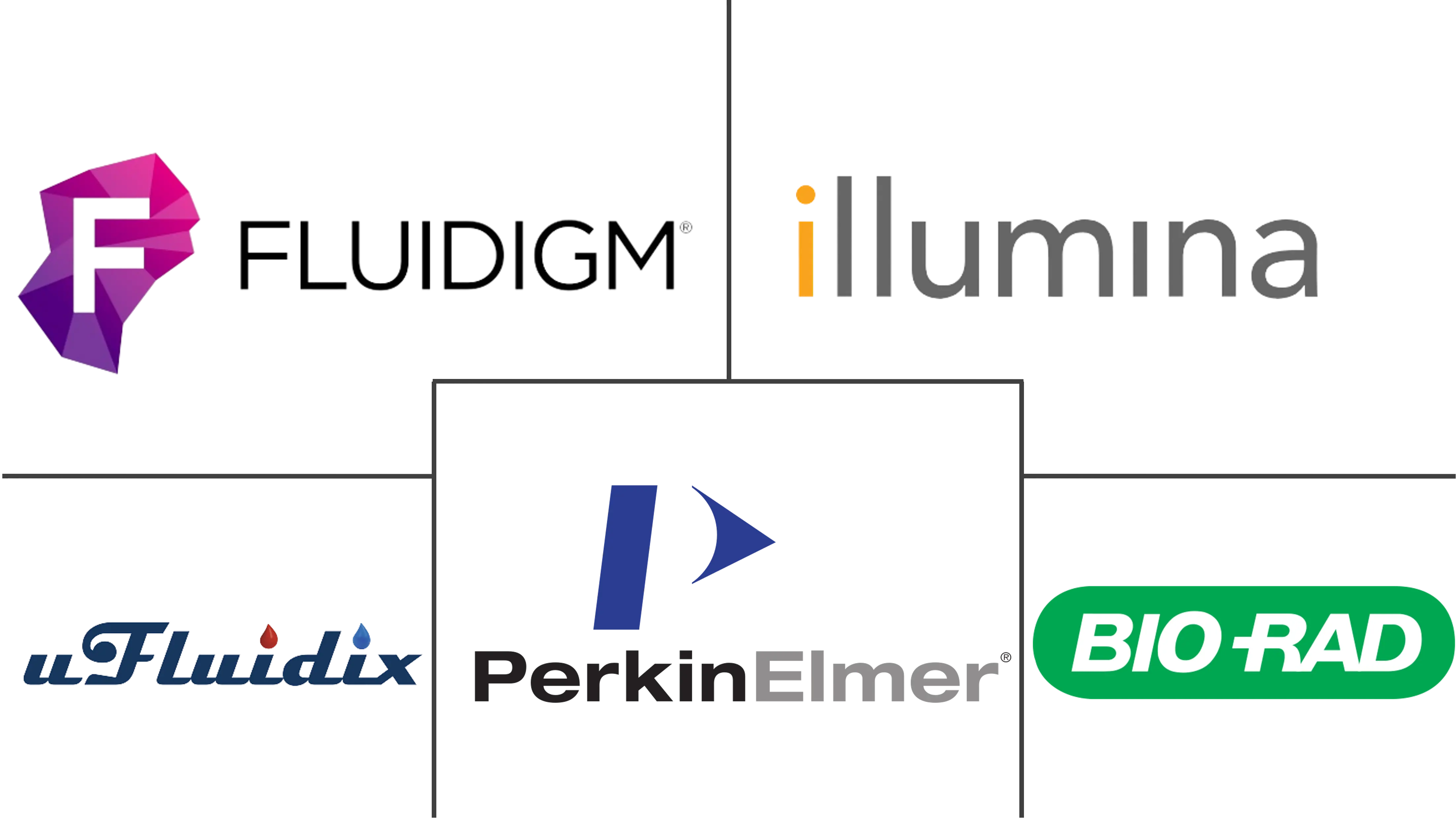
*Disclaimer: Major Players sorted in no particular order |
Microfluidics Market Analysis
The Microfluidics Market size is estimated at USD 32.58 billion in 2024, and is expected to reach USD 64.94 billion by 2029, growing at a CAGR of 14.79% during the forecast period (2024-2029).
The factors propelling the market's growth are the increasing demand for point-of-care testing, rising incidences of various diseases, the faster turnaround time for analysis, and improved device portability.
The rising burden of infectious diseases and chronic diseases such as cancer, diabetes, cardiovascular diseases, and others increases the demand for point-of-care testing, which is expected to propel the demand for the microfluidics market during the forecast period. For instance, according to the 2022 statistics published by the International Diabetes Federation (IDF), in Germany, about 6.1 million people lived with diabetes in 2021, projected to reach 6.5 million by 2030. Thus, the expected increase in the number of people with diabetes raises the need for novel porous microcapsules encapsulating β cells for diabetes treatment using microfluidic electrospray technology.
As cancer cases increase, the demand for advanced cancer therapy rises, expected to drive market growth during the forecast period. For instance, according to the data updated by the National Cancer Center of Japan, an estimated 1 million new cancer cases were diagnosed in Japan in 2023. Microfluidic devices mimic the cancer metastasis process and are usually applied to several cell types to culture two or more organoids. Thus, increasing cancer cases is expected to boost market growth during the forecast period.
According to the 2022 statistics published by Dementia Australia, 487,500 Australians lived with dementia in Australia in 2022, and this number is projected to reach about 1.1 million by 2058. Thus, the increasing burden of dementia among the target population raises the need for effective drug discovery, screening methods, and toxicology studies. This increases the demand for microfluidics systems that can be used to grow neurites, glial cells, endothelial cells, and skeletal muscle cells, along with the maintenance of fluid isolation, and provides an opportunity to investigate organogenesis and disease etiology.
The developments in microfluidics are also leading to the evolution of a cost-effective mass-production process for diagnostic devices. Smartphones paired with microfluidics enable the deployment of point-of-care testing. This has widened the application of microfluidic devices and is expected to expand.
The rising focus on developing microfluidics technologies and devices and the increasing adoption of various strategic initiatives are expected to drive the market's growth during the forecast period. For instance, in October 2022, Standard BioTools Inc. launched the X9 Real-Time PCR System, which uses microfluidics technology to provide a flexible and productive high-capacity genomics platform.
However, the integration of microfluidics technology with existing workflows and the low adoption in developing countries due to high prices are expected to hinder the market's growth during the forecast period.
Microfluidics Market Trends
The Point-of-Care Diagnostics Segment is Expected to Witness Considerable Growth During the Forecast Period
The point-of-care diagnostics segment is expected to witness significant growth in the microfluidics market during the forecast period due to the rising prevalence of chronic diseases, increasing demand for point-of-care testing devices, and technological advancements. For instance, according to the data updated by Cancer Australia in 2023, an estimated 162,163 cancer cases were diagnosed in Australia in 2022. Thus, the high prevalence of cancer cases is anticipated to increase the demand for point-of-care diagnostics, propelling the market's growth.
Ongoing research and technological advancements are continually improving the capabilities of microfluidics technology, and these innovations are expanding the range of applications and increasing the accuracy and sensitivity of point-of-care diagnostics, which are the key market drivers for adopting microfluidic technology. For instance, according to the research published by the Biosensors Journal in March 2023, microfluidics technology is being extensively researched owing to its benefits, such as quick operation, less reagent requirement (microliter or even nanoliter), and a significantly high integration capability, such as sample preparation, detection, and analysis into a single platform.
The major advantages associated with the devices are rapid and precise response, cost-effectiveness, and portability. Research is being done in point-of-care diagnostics to develop a chip-based device that can examine multiple analytes in complex samples. Hence, the integration of microfluidics is believed to contribute to the improvisation of point-of-care diagnostics.
Therefore, as the range of POC diagnostics expands, microfluidics will also grow significantly, which may enable the development of new devices.
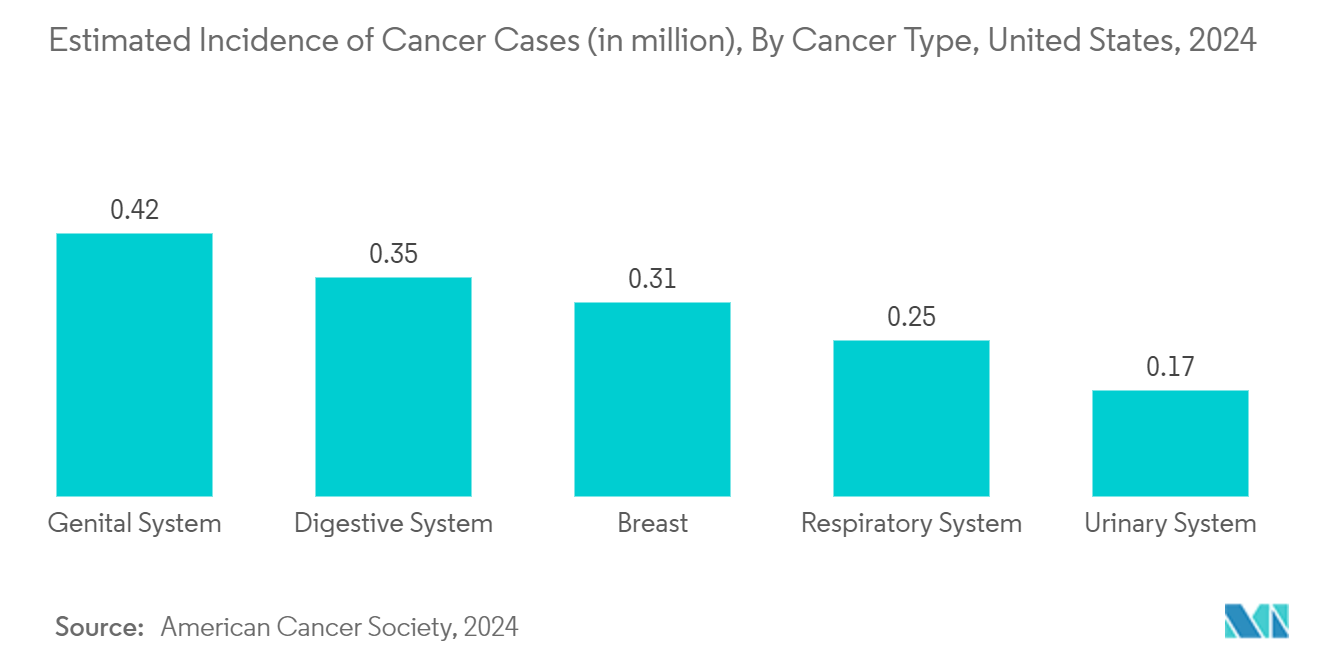
North America is Expected to Witness Significant Growth During the Forecast Period
North America is expected to witness considerable growth in the microfluidics market. It is expected to hold a significant share during the forecast period due to factors such as the well-established healthcare system, the higher adoption of novel therapeutics among the general population, and the increasing prevalence of infectious and chronic diseases among the region's population.
For instance, according to the data published by the International Agency for Research on Cancer, there were around 8,600 liver cancer cases in 2022, and it is projected to reach 11,200 liver cancer cases by 2030 in Mexico. Similarly, according to the data published by the Canadian Cancer Society in November 2023, an estimated 239,100 Canadians were expected to be diagnosed with cancer in 2023, and around 45.0% of the individuals in Canada will be diagnosed with cancer in their lifetime. Hence, such a growing burden of cancer in the region is expected to fuel the demand for microfluidics and favor market growth.
The United States is expected to grow considerably in North America due to the rising burden of cancer cases and investment in the pharmaceutical industry. Microfluidics is a vastly growing field in the region with a high budget for R&D. This is expected to increase the segment's growth during the forecast period. The point-of-care diagnostics uses microfluidic technology for various applications, like molecular diagnostics, infectious diseases, and chronic diseases, which aim to produce integrated microfluidic devices that are easy to use and rapid. The rising burden of cancer is also expected to fuel the demand for microfluidics. For instance, in January 2024, according to the American Cancer Society, it was estimated that more than 2.0 million cancer cases would be diagnosed in the United States in 2024, an increase from 1.9 million cancer cases in 2023. Hence, the country's growing burden of cancer is expected to fuel the demand for microfluidics and favor market growth.
Thus, due to the above-mentioned factors, such as the rising prevalence of chronic diseases and the increasing usage of microfluidics, the microfluidics market in North America is expected to grow at a healthy rate.
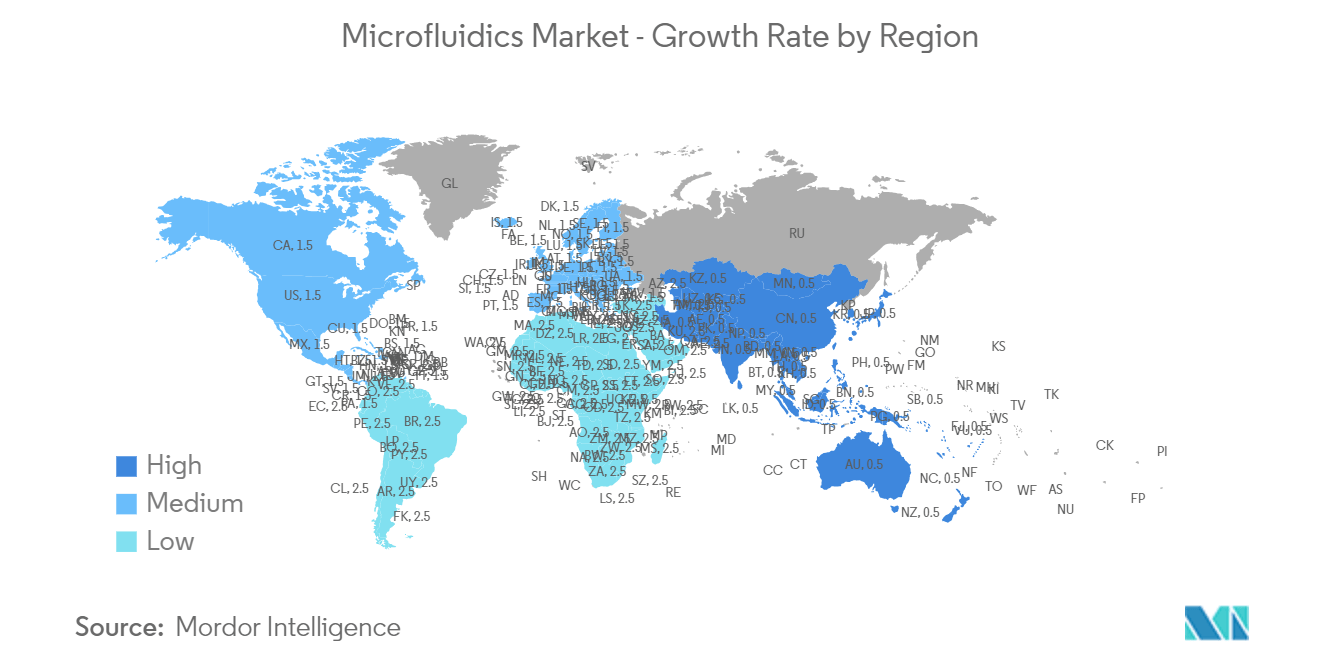
Microfluidics Industry Overview
The microfluidics market is fairly competitive, and in terms of market share, few major players dominate the market. However, with technological advancements and product innovations, mid-size to smaller companies are increasing their market presence by introducing new technologies at affordable prices. Companies like uFluidix, Bio-Rad Laboratories Inc., Fluidigm Corporation, Illumina Inc., and PerkinElmer Inc. hold a substantial market share. The key players have been involved in various strategic alliances such as acquisitions, collaborations, and launches of advanced products to secure their positions in the global market.
Microfluidics Market Leaders
-
uFluidix
-
Bio-Rad Laboratories Inc.
-
Fluidigm Corporation
-
Illumina Inc.
-
PerkinElmer, Inc.
*Disclaimer: Major Players sorted in no particular order
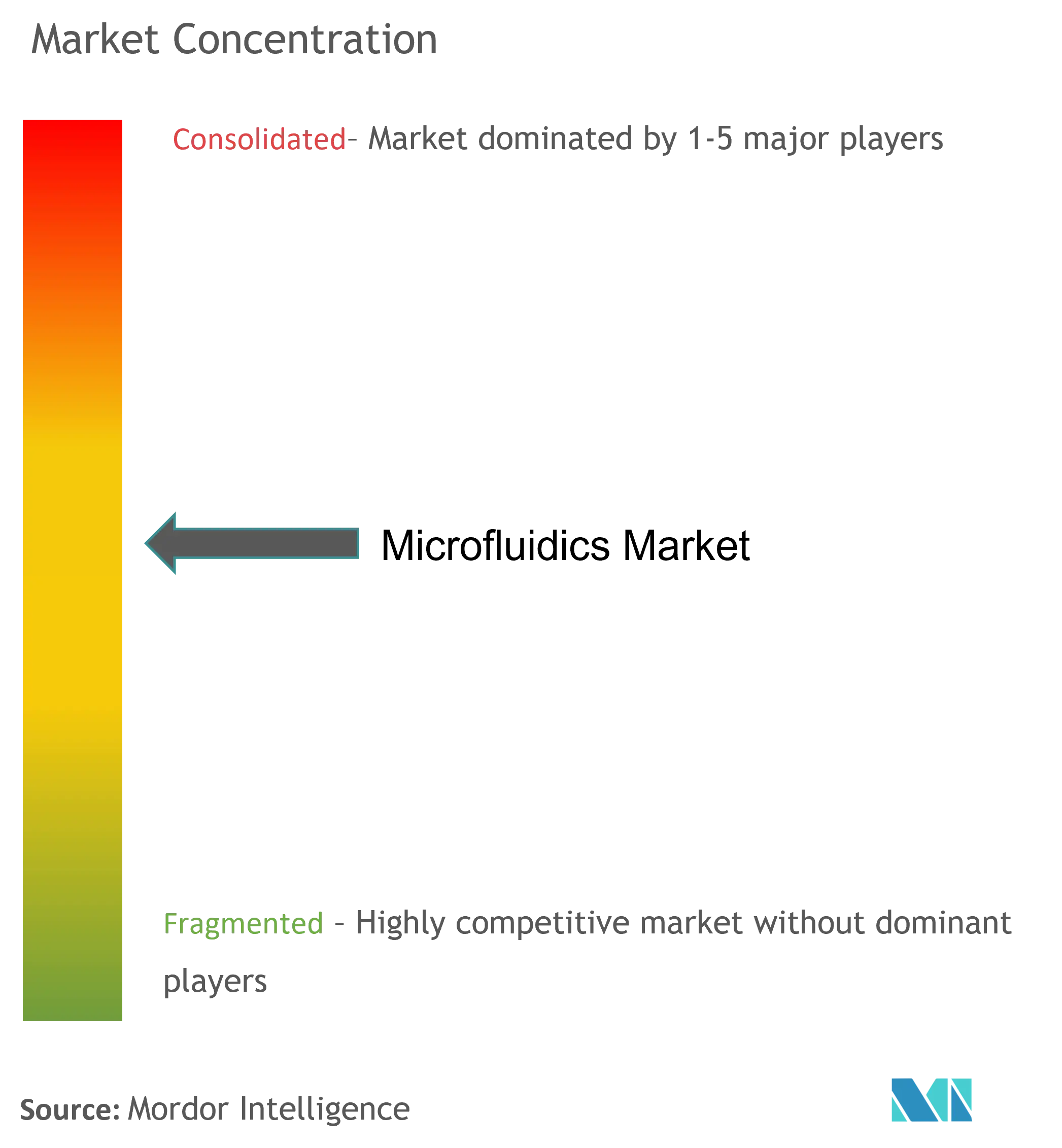
Microfluidics Market News
- November 2023: Microfluidics, a unit of IDEX Material Processing Technology (MPT), launched Microfluidics’ newest processor, which is designed for production scale cell disruption, which is used in the manufacturing of many biological products such as antigens for vaccines and viral vectors that deliver genes for next-generation gene therapy.
- January 2023: SCIEX launched the Intabio ZT system, the first fully-integrated microfluidic chip-based platform combining imaged capillary isoelectric focusing (icIEF) separation and UV detection.
Microfluidics Market Report - Table of Contents
1. INTRODUCTION
- 1.1 Study Assumptions and Market Definition
- 1.2 Scope of the Study
2. RESEARCH METHODOLOGY
3. EXECUTIVE SUMMARY
4. MARKET DYNAMICS
- 4.1 Market Overview
-
4.2 Market Drivers
- 4.2.1 Increasing Demand for Point-of-care Testing
- 4.2.2 Increasing Incidences of Various Diseases
- 4.2.3 Faster Turn-around Time for Analysis and Improved Portability of Devices
-
4.3 Market Restraints
- 4.3.1 Integration of Microfluidics Technology with Existing Workflows
- 4.3.2 Low Adoption in Developing Countries Due to High Prices
-
4.4 Porter's Five Forces Analysis
- 4.4.1 Threat of New Entrants
- 4.4.2 Bargaining Power of Buyers/Consumers
- 4.4.3 Bargaining Power of Suppliers
- 4.4.4 Threat of Substitute Products
- 4.4.5 Intensity of Competitive Rivalry
5. MARKET SEGMENTATION (Market Size by Value - USD)
-
5.1 By Product Type
- 5.1.1 Microfluidic-based Devices
- 5.1.2 Microfluidic Components
- 5.1.2.1 Microfluidic Chips
- 5.1.2.2 Micro Pumps
- 5.1.2.3 Microneedles
- 5.1.2.4 Other Product Types
-
5.2 By Application
- 5.2.1 Drug Delivery
- 5.2.2 Point-of-care Diagnostics
- 5.2.3 Pharmaceutical and Biotechnology Research
- 5.2.3.1 High-throughput Screening
- 5.2.3.2 Proteomics
- 5.2.3.3 Genomics
- 5.2.3.4 Cell-based Assay
- 5.2.3.5 Capillary Electrophoresis
- 5.2.3.6 Other Pharmaceutical and Biotechnology Research
- 5.2.4 Clinical Diagnostics
- 5.2.5 Other Applications
-
5.3 By Material
- 5.3.1 Polymer
- 5.3.2 Silicone
- 5.3.3 Glass
- 5.3.4 Other Materials
-
5.4 By Geography
- 5.4.1 North America
- 5.4.1.1 United States
- 5.4.1.2 Canada
- 5.4.1.3 Mexico
- 5.4.2 Europe
- 5.4.2.1 France
- 5.4.2.2 United Kingdom
- 5.4.2.3 Germany
- 5.4.2.4 Italy
- 5.4.2.5 Spain
- 5.4.2.6 Rest of Europe
- 5.4.3 Asia-Pacific
- 5.4.3.1 China
- 5.4.3.2 Japan
- 5.4.3.3 India
- 5.4.3.4 Australia
- 5.4.3.5 South Korea
- 5.4.3.6 Rest of Asia-Pacific
- 5.4.4 Middle East and Africa
- 5.4.4.1 GCC
- 5.4.4.2 South Africa
- 5.4.4.3 Rest of Middle East and Africa
- 5.4.5 South America
- 5.4.5.1 Brazil
- 5.4.5.2 Argentina
- 5.4.5.3 Rest of South America
6. COMPETITIVE LANDSCAPE
-
6.1 Company Profiles
- 6.1.1 UFluidix
- 6.1.2 Bio-Rad Laboratories Inc.
- 6.1.3 Emulate Inc.
- 6.1.4 Dolomite Microfluidics (Blacktrace Holdings Ltd)
- 6.1.5 Sphere Fluidics Limited
- 6.1.6 FluIdigm Corporation
- 6.1.7 Illumina Inc.
- 6.1.8 Micronit Microfluidics
- 6.1.9 PerkinElmer Inc.
- 6.1.10 Hesperos Inc.
- 6.1.11 ZEON CORPORATION
- 6.1.12 Bartels-Mikrotechnik
- 6.1.13 Agilent Technologies Inc.
- 6.1.14 Quidel Corporation
- 6.1.15 Fluigent SA
- 6.1.16 Nanomix Inc.
- 6.1.17 Biosurfit SA
- *List Not Exhaustive
7. MARKET OPPORTUNITIES AND FUTURE TRENDS
** Subject To AvailablityMicrofluidics Industry Segmentation
As per the scope of the report, microfluidics is a medical approach involving the precise control of small fluid samples for medical analysis. The sample sizes in microfluidics range from microliters to picoliters. At such low volumes, fluid transportation is governed significantly by its mass. The microfluidics market is segmented into product type, application, material, and geography. By product type, the market is segmented into microfluidic-based devices and microfluidic components. By microfluidic components, the market is segmented into microfluidic chips, micro pumps, microneedles, and other product types. By application, the market is segmented into drug delivery, point-of-care diagnostics, pharmaceutical and biotechnology research, clinical diagnostics, and other applications. By pharmaceutical and biotechnology research, the market is segmented into high-throughput screening, proteomics, genomics, cell-based assay, capillary electrophoresis, and other pharmaceutical and biotechnology research. By material, the market is segmented into polymer, silicone, glass, and other materials. By geography, the market is segmented into North America, Europe, Asia-Pacific, the Middle East and Africa, and South America. The report also covers the estimated market sizes and trends for 17 countries across major regions globally. The report offers the value (in USD) for the above segments.
| By Product Type | Microfluidic-based Devices | |
| Microfluidic Components | Microfluidic Chips | |
| Micro Pumps | ||
| Microneedles | ||
| Other Product Types | ||
| By Application | Drug Delivery | |
| Point-of-care Diagnostics | ||
| Pharmaceutical and Biotechnology Research | High-throughput Screening | |
| Proteomics | ||
| Genomics | ||
| Cell-based Assay | ||
| Capillary Electrophoresis | ||
| Other Pharmaceutical and Biotechnology Research | ||
| Clinical Diagnostics | ||
| Other Applications | ||
| By Material | Polymer | |
| Silicone | ||
| Glass | ||
| Other Materials | ||
| By Geography | North America | United States |
| Canada | ||
| Mexico | ||
| By Geography | Europe | France |
| United Kingdom | ||
| Germany | ||
| Italy | ||
| Spain | ||
| Rest of Europe | ||
| By Geography | Asia-Pacific | China |
| Japan | ||
| India | ||
| Australia | ||
| South Korea | ||
| Rest of Asia-Pacific | ||
| By Geography | Middle East and Africa | GCC |
| South Africa | ||
| Rest of Middle East and Africa | ||
| By Geography | South America | Brazil |
| Argentina | ||
| Rest of South America |
Microfluidics Market Research FAQs
How big is the Microfluidics Market?
The Microfluidics Market size is expected to reach USD 32.58 billion in 2024 and grow at a CAGR of 14.79% to reach USD 64.94 billion by 2029.
What is the current Microfluidics Market size?
In 2024, the Microfluidics Market size is expected to reach USD 32.58 billion.
Who are the key players in Microfluidics Market?
uFluidix, Bio-Rad Laboratories Inc., Fluidigm Corporation, Illumina Inc. and PerkinElmer, Inc. are the major companies operating in the Microfluidics Market.
Which is the fastest growing region in Microfluidics Market?
Asia Pacific is estimated to grow at the highest CAGR over the forecast period (2024-2029).
Which region has the biggest share in Microfluidics Market?
In 2024, the North America accounts for the largest market share in Microfluidics Market.
What years does this Microfluidics Market cover, and what was the market size in 2023?
In 2023, the Microfluidics Market size was estimated at USD 27.76 billion. The report covers the Microfluidics Market historical market size for years: 2019, 2020, 2021, 2022 and 2023. The report also forecasts the Microfluidics Market size for years: 2024, 2025, 2026, 2027, 2028 and 2029.
What are the factors driving the Microfluidics Market?
The factors driving the Microfluidics Market are a) Rising applications in drug discovery and research b) Growing adoption in microfluidic-based drug delivery systems
Microfluidics Device Industry Report
The global microfluidics market is experiencing remarkable growth, driven by the demand for advanced diagnostics and an uptick in chronic diseases. Innovations in lab-on-a-chip and point-of-care diagnostics are rapidly advancing healthcare by enhancing diagnostic speed, accuracy, and cost-effectiveness. The integration with PCR for swift detection and innovations in drug delivery systems underscore microfluidics' role in evolving healthcare towards more effective and controlled solutions.
North America, with significant R&D and a strong healthcare infrastructure, leads market expansion into diverse applications, making diagnostics more accessible and revolutionizing healthcare efficiency. This evolution reflects microfluidics' pivotal role in shaping future medical science and global health betterment, as detailed in industry analyses by Mordor Intelligence™.
The market size and forecasts are provided in terms of value for all the above segments. The global market is segmented by product type, application, material, and geography. The market growth is driven by demand in various sectors such as drug delivery, point-of-care diagnostics, and pharmaceutical and biotechnology research.
The industry analysis shows that microfluidics is pivotal in enhancing diagnostic speed, accuracy, and cost-effectiveness. The market forecast predicts continued growth, driven by advancements in lab-on-a-chip technologies and point-of-care diagnostics. Industry reports highlight North America's role in leading market expansion and making diagnostics more accessible.
The market overview indicates that innovations in drug delivery systems are also playing a significant role in the market's evolution. The industry outlook is positive, with the market segmentation showing diverse applications across different regions. The market leaders are focusing on R&D to further revolutionize healthcare efficiency.
The industry information provided by Mordor Intelligence™ emphasizes the importance of microfluidics in shaping future medical science. The market data supports the industry trends of increasing demand for advanced diagnostics. The market review and market predictions highlight the continuous growth and innovation in the microfluidics market.



